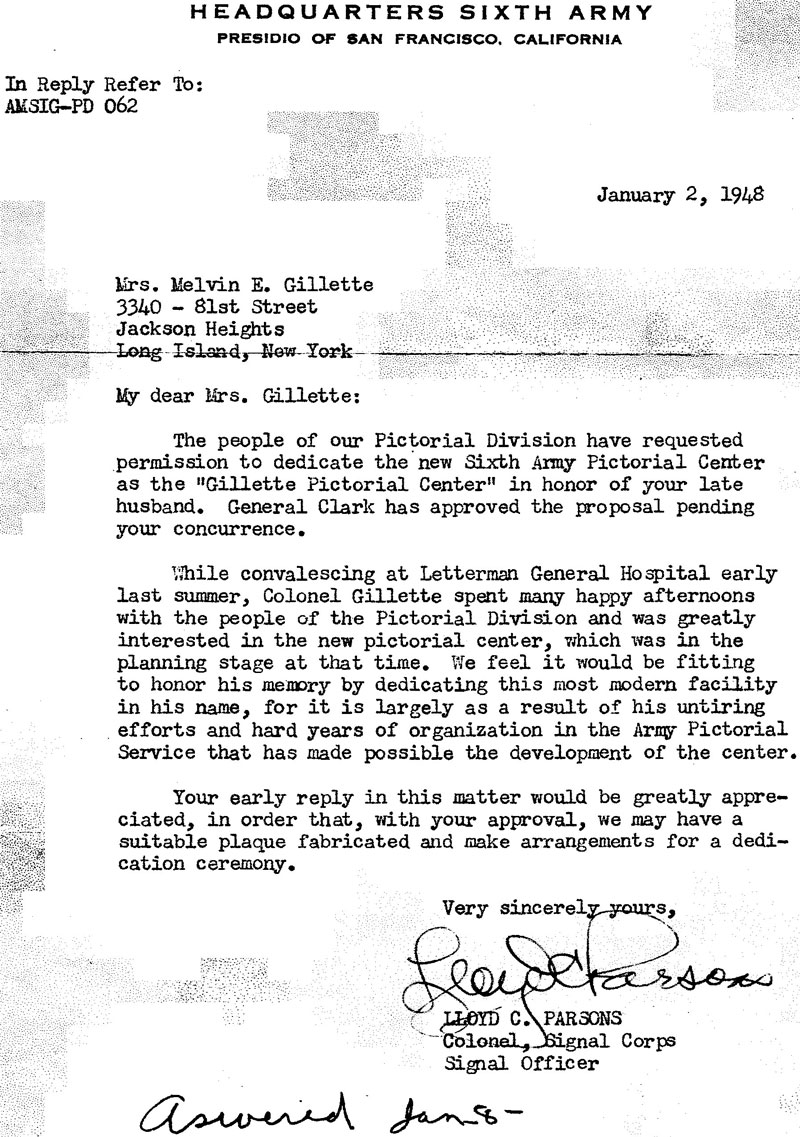 |
|||||
|
Colonel Melvin E. Gillette
The First Commander Col. Melvin E. Gillette, the "architect of Military Pictorial Service" organized and direct Fort Monmouth's first training Film Field Unit in 1937 and the first Training Film Production Laboratory in 1940. When the laboratory was moved to Long Island City in 1942 and was incorporated into the new Signal Corps Photographic Center, Long Island City, New York, Col. Gillette became the Center's first commanding officer. Col. Gillette was born in Berwick, Ill. On Nov. 15, 1892. After receiving his bachelor of arts degree from Des Moines (Iowa) College, he served with the Iowa National Guard, first on the Mexican Border and, with the outbreak of World War I, with the Guard's Quartermaster Corps. In 1920 he received a Regular Army commission in the Infantry and served for the ensuing nine years as an Infantry officer. Three of those nine years were spent in the Canal Zone. His Signal career started in 1929 when he transferred to the Signal Corps. He became immersed in the Corp's pictorial branch and studied motion picture production methods in Hollywood, headed the Signal Corps Photographic Laboratory in Washington, D.C., and was actively engaged in the production of military educational film before organizing the field film unit at Fort Monmouth, New Jersey. Gillette served as the Army pictorial representative on Gen. Dwight D. Eisenhower's Allied Headquarters staff in North Africa and as photographic officer with the Fifth Army in Italy under Gen. Mark Clark. He was decorated with the Legion of Merit for his service with the Fifth Army for "planning and establishing an effective photographic system to cover the Allied operations in Italy." His citation states further:
In 1945 he served as pictorial officer for MIDPAC and later as deputy signal officer and chief signal officer, AFMIDPAC. He returned to San Francisco in January 1947, suffered a heart attack that July and died on September 11, 1947. Col. Gillette also held the Bronze Star for his service with MIDPAC, the World War I and II Victory Medals, the World War I Mexican Border Service Medal and several campaign ribbons. In 1948, the Pictorial Center of the Presidio, San Francisco was dedicated in his memory and named the Gillette Pictorial Center (see letter below). Colonel Gillette is buried at Arlington National Cemetery, Washington, D.C.
(This photo was forwarded by Tom Sullivan. The biography was provided by the command historian at Ft. Monmouth, New Jersey.)
Find more about Col. Gillette at this site: http://www.thelastfarewell.net/196th_SPC_Melvin_Gillette_Architect_of_APS.htm
Jake Thorn of Illinois provided this copy of the Sixth Army letter regarding naming the Gillette Pictorial Center:
Mr. Thorn subsequently shared an e-mail about Colonel Gillette: "In my pursuit to trace my grandmother's Gillett Family History, I have discovered that U. S. Army Col. Melvin E. Gillette is my grandmother's first cousin. "Actually, I have had Melvin in my tree for ages, but I could not find any historical background on him, until a cousin of mine mentioned that we had a Gillett relative buried at Arlington National Cemetery. That turned out to be Melvin. "Further on, I have managed to make contact with a grandson of Col. Gillette, who mentioned that he has a number of negatives that his grandfather took, as well as a few letters relevant to the building at the Presidio being named in Col. Gillette's honor. The grandson was hoping to share these historical items with the folks at Gillette Photographic Center, but we find that it no longer owned by the U.S. Army. The grandson is proud of his grandfather's contribution to America and may still be interested in sharing what he has preserved from his grandfather. "We are also interested in what happened to the plaque used in the dedication of the Gillette Photographic Center, or what the status currently is. It was a bit of a disappointment for our family to find that the building was no longer dedicated to Col. Gillette." Updated September 22, 2010, and June10, 2019. |
|
||||













